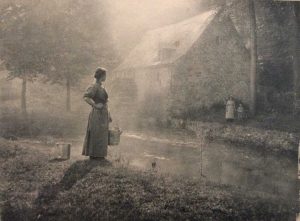
Leonard Misonne (Belgium 1870-1943)
- Original Pictorialism, a brief history
In 1861, William Morris in the U.K. founded the furniture company Morris, Marshall, Faulkner, and Company. This company was to counter the banal and mechanical direction interior decorating and furniture making was going. Many British furniture makers and home decorators at the time were fed up with the industrialization of that industry at the expense of the centuries old dedication and craftsmanship. In their eyes, it became all about money and speed. Morris, Marshall, Faulkner, and company is considered the start of the Arts and Crafts Movement, which is still active today.
It is safe to say that pictorialism started in the late 1860s in England. The movement probably begun in 1869 when Henry Peach Robinson published Pictorial Effect in Photography. The book was an attempt to separate photography from the scientific photographic applications and steer photography into the direction of an art medium. Even though it took another two decades before the movement gained ground, the seed was planted with Robinson’s publication.
That these two art related movements planted their seeds right around the same time might be a coincidence, but I don’t think so. Artists of all disciples became tired of the mechanical and industrial direction interior decorating, including wall art, had taken.
In the late 19th century, the main source of income for professional photographers was portraits. Painters and photographers were competing in this discipline. To get a competitive advantage over portrait painters and to branch out photography into other categories such as landscapes, photographers looked at painting styles such as the Barbizon School for landscapes and Impressionism for style. All these influences, that started with Robinson, led into the movement we know as pictorialism. Even the name “Pictorialism” is derived from the title of Robinson’s book.
The movement lasted until about 1911-1915. When “straight” or “pure” photography became the order of the day. Straight or pure photography is pretty much the opposite of pictorialism. (“Straight” was used on the east coast by Stieglitz and his followers and the term “Pure” was introduced a few years later by the group f/64 on the west coast. It means the same thing.) Besides some contrast manipulation in the darkroom, no manipulation was allowed, and everything had to be as sharp and clear as possible. Paul Strand and Alfred Stieglitz were at the frontlines of this new thing “Straight” photography. This is interesting because Alfred Stieglitz was the one who introduced pictorialism to America and the one who practically ended it with his image “The Steerage”. This famous image was captured in 1907 but published 4 years later in Stieglitz’s publication “Camera Works” together with a cubist drawing by Picasso and introduced as the new style.

“The Steerage” – Alfred Stieglitz 1907
Under the influence of Stieglitz, photography began to be presented as an art form in its own right without the need to imitate traditional art.
Professional painters by the way, were not completely innocent either. Their main source of income was, like photography, portraits as well, and they were afraid that portrait photography would take a good chunk out of that market that they considered “their” market. So, they started to imitate photographs more and more with realistic and hyper realistic paintings and drawings. (See my blog post “Bob Ross”)
So, what is this pictorialism exactly? Pictorialism is the manipulation of photographic materials, such as negatives and paper, with the goal to obtain a more artistic look that could compete with traditional two dimensional art. Some of the techniques used to accomplish this were developing with coffee, the scratching of the negatives, soft focus and other filters, and specialized printing processes such as gum bichromate, which you might know as gelatin or gum arabic. Sometimes a pigment was added to give the final print any color coating the photographer wanted.
The image “The Pond – Moonlight” below was created by Edward Steichen in 1904. He obtained the blue-ish color by applying gum bichromate with a blue pigment. The print was sold for $2.9 million dollars in 2006 to a private collector. The highest amount ever paid for a photograph at the time. There are only two prints in existence, and both were owned by the Metropolitan Museum for Modern Art until they decided to sell one of the two.
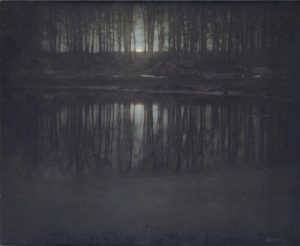
“The Pond – Moonlight” – Edward Steichen 1904.
Even though the pictorialism movement fell apart in the 1910s, it never really went away. Adolf Fassbinder was a mid-20th century artist for example who never gave up pictorialism. Throughout the whole life cycle of analog photography, photographers always enjoyed the manipulation of the photographic outcome one way or the other. Special effects filters such as soft focus, star, or prism filters were popular. Alternative photographic techniques also remained popular on and off. Especially in the late sixties and early seventies, screen printing was popular. Hot waxing, wood printing, and the manipulation of polaroid images, such as emulsion lifts and emulsion transfers, were, and to an extend still are, popular with artists.
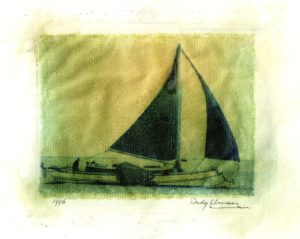
Polaroid transfer image sample
Created by me. The original was a Black and White darkroom print, reproduced on color polaroid film that was peeled apart during the developing and transferred to rice paper.
A reproduction is available here: https://fineartamerica.com/featured/polaroid-boat-rudy-umans.html
- Other Alternative methods
There are other photographic methods that look like pictorialism but cannot be considered true pictorialism in my opinion, because some of those processes are characteristics and inherent to the technique itself. It is part of the process without interference of the artist. Pinhole photography is one of those processes for instance in my opinion. Wet plate Collodion (Glass negatives and the name Sally Mann might ring a bell) and the well-known daguerreotype are other methods to capture images. These methods were normal processes for the time and that they looked like artsy pictures was more considered a flaw that was subject to improvements than anything else. They certainly did not make them look artsy on purpose as was done during the pictorialism era. Many of these processes are still popular today.
- Digital era and Modern Pictorialism
Photo manipulation in the digital era really started in 1987 with the first commercially available version of Photoshop. This image editing computer program was developed to edit digital scans. The Digital Camera was already invented but not on the general commercial market until 1989 when Fujifim came out with the Fujix DS-X. Initially, photoshop was only available for the Apple MacIntosh. Meaning the market was still very limited and the program was really to enhance the digital scans and not to manipulate the image pictorialism style.
The popularity of Photoshop increased considerably when they came out in 1993 with a version for Windows. The Windows version was also the encouragement third party software companies needed to develop their own image manipulation software programs. To my knowledge, the first one to do so was NIK. In 1995, NIK came out with the ”NIK Collection” that consisted of Nil’s Efex and Nil’s Type Efex. (No Nil is not a typo) These programs included textures for Adobe Photoshop that reproduced the effect of the optical filters that were placed in front of the camera lens. Between 1999 and 2002, NIK added three new software programs, one of them was “Color Efex Pro” for color conversions. In 2005, Topaz labs came out with similar programs for video and still photography.
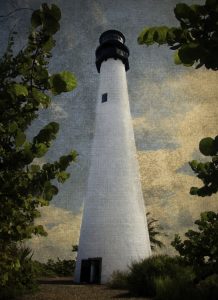
Heavily manipulated image with color – and textures filters
Available here: https://fineartamerica.com/featured/cape-florida-lighthouse-1-rudy-umans.html
Although I did not officially research the market for aftermarket digital filters to manipulate digital images, there seems to be a substantial growth in the availability of these filters. In other words, there seems to be a growing demand on which new and existing software developers react. Apparently, there is money to be made. All these developers compete with one and another and they all try to get the competitive edge. One way to get that is affordability. A low price point makes it available for a greater market share. Another way is ease of use. The development of computer and software technology made quantum leaps over the last few years to the advantage of the consumer. It became easier and easier to apply filters to any digital image. The range of type of filters also expanded enormously. Today, with the click of a few keystrokes, one can change a normal digital image into an (virtual) oil painting, watercolor, or pencil drawing. Don’t like the color of the sky? No problem. There is a preset for that. Rather be a red head than a brunette? Give me one second……. It seems that this is just the start, with the arrival of creative AI, the sky is the virtual limit.
There are also modern lenses for digital cameras on the market especially designed to manipulate and distort the image. Specialty companies design and sell lenses that cause lens flares (light streaks and other light abnormalities that other lens manufactures try to eliminate at all cost), or are anamorphic, which distort the perspective to make everything looked curved, or distort the subject another way. These lenses have the sole purpose to make the image look artsy.
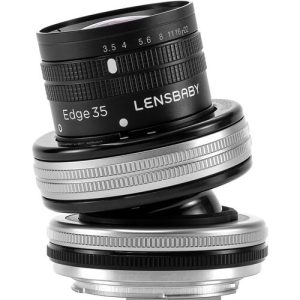
Modern specialty lens with the sole purpose to make the image look artsy with the help of lens distortions.
Just like the old days when it was popular among photographers to make their photographs look like a traditional painting, the very same thing is popular again. The only difference is that modern technology makes it possible for anybody to make a digital image look like traditional art and very few technical skills are required. This availability and ease of use has the result that the popularity of the pictorialist style and pictorialism inspired images grew tremendously over the last number of years.
Although these programs are very popular, that market is really limited to advanced amateurs and professional creatives (as digital artists and photographers are called sometimes nowadays). We are not talking about the public at large. This market came into the picture (Pun or no pun? Your choice) in 2010 with the arrival of the Apple iPhone 4 as the first cell phone camera with a front facing camera.
- Beauty filters for selfies
When Apple came out in 2010 with the IPhone 4 with a front facing camera, the popularity of selfies dramatically increased. However, the technical quality of the cell phone cameras and software in those days was nothing to write home about, and were not very flattering for self-conscious individuals.
Fortunately, it didn’t take long for third party software developers to come to the rescue. The first one was Instagram, that was launched in the same year as the IPhone 4. In the same year, Instagram came out with a set of filters to help this group of users out. A year later they introduced “live filters” which allowed to preview the effect of any of the live filters. These filters were known as “Instagram Filters”.
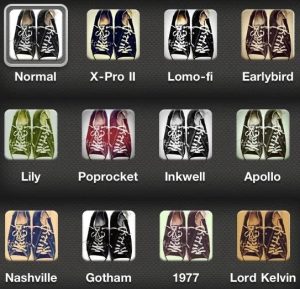
The original Instagram filters.
A year after the introduction of the Instagram filters, Piccaboo, later called SnapChat, introduced similar filters.
Third party image enhancing applications could obviously not improve the technical quality of the cameras, but they could disguise the shortcomings and that’s exactly what they did by giving the images a more artistic painterly look. Cell phone designers and manufactures should be grateful to companies like Instagram, they surely contributed a lot to popularity of the cell phone camera, which encouraged the further development of the cell phone cameras we know today.

Instagram Live Filters
- Why?
The short answer is that I don’t know why. The long answer is also I don’t know why, but not in so many words.
Having said that, I do have some thoughts though that I would like to run by you.
I am not a psychologist, nor do I pretend to be one, but to me it seems obvious that people have a need to create, and not just in art. All the modern aids to create are not satisfying for many people. They want more. They long for some old fashioned craftsmanship. However, for most it is unfortunately not possible for a variety of reasons, or too cumbersome to express their creativity the old fashioned way, so they resort to the next best thing: the computer. With the help of the computer and software, they are able to get the pictorialism like results without the mess. There is no need for chemicals, no need for a darkroom, a short learning curve, and an instant result. Except for one, there are no real drawbacks in using the computer, it is still fun and probably better for your marriage or other long term relationships. One drawback is the risk it all becomes cookie cutter.
That takes me to another group of practitioners. This group has the need to be different from the first group. This group can be split up in two very different groups.
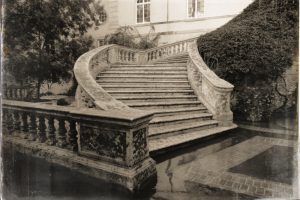
Another manipulated image complete with digital scratches, filters, and light leaks
Available here: https://fineartamerica.com/featured/5835-hialeah-racetrack-stairs-rudy-umans.html
The first subgroup are people with a strong internet presence such as social media influencers with a large following. I understand that many of these influencers have the need for a signature style, for something that makes them stand out in an apparently very competitive occupation. One way for some of them is to apply a particular special effects filter to their images that makes them stand out and instantly recognizable. I learned about this while doing research for this blog and before that, I had no clue. I know very little about “social media influencers” and I couldn’t name one of them if my life depended on it.
The second subgroup likes to stand out also but likes to do it the hard way. This group sympathizes with the 1860s Arts and Craft Movement and likes to keep the craft of photography alive. Although not necessarily pictorialists, but they prefer to take the time and the effort to things the old fashioned way as far as their art is concerned. Sometimes just for the pure enjoyment and sometimes also to stand out from the competition. Art is a competitive field also.
Obviously, one needs to have time. money (it can get expensive), and space to actually practice those traditional photographic techniques and not everybody has that. Those people that don’t are the hybrids. These people do as much the old fashioned way as their circumstances allow and the rest is scanned and done digitally. But even after the image is scanned, I have yet to meet (online or in person) anyone who digitally manipulated their images beyond what could have been done in an old fashioned darkroom. There is however “The Lemonade Exception” as my picture below.

Francis S Taylor Wildlife Management Area
This image was captured on film but severely underexposed, so I did the only thing I could do other than throwing it out, I made lemonade and gave it a pictorialistic effect.
Available here: https://fineartamerica.com/featured/francis-s-taylor-wma-rudy-umans.html
Whether one belongs to one of these boxes or not, we all have a need to let our individualism shine even though we all belong to the same organism. My guess is that nobody likes to be lost in a lost world (Moody Blues song). The arts and crafts world might look very different in the future once we figured out there is an inevitable way how to be individuals without getting lost.
—————
This was the last of my blog posts for a while. I am taking a break. I will be back in the late spring when it gets too hot to be outside.
I will not rest on my laurels though, there are a lot of things I want, need, and will do related to photography. If you like to stay up to date of my little photographic adventures, new books, new work, and who knows what else might come up, please sign up for my newsletter here. https://rudyumans.com/newsletter-sign-up/ I promise not to bombard you with junk, or emails that you will cause you to lament “Oh no, not him again”. I like to keep it fun, interesting, while keeping you in mind.
This same blog post will also be published on my personal site https://rudyumans.com/
Rudy Umans
November 2023
————–
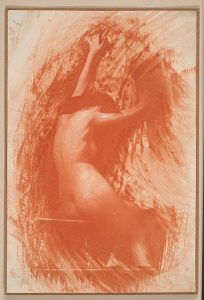
Robert Demanchy – 1903
Before I go, some disclaimers.
Some disclaimers.
Images and text that are created by the author of this article enjoy copyright protection as defined by the laws of the United States and the rules of the World Intellectual Property Organization (WIPO) of which the United States is a member. All other images and quotes are used under the “Fair Use” doctrine. (Educational)
Also, the above are strictly my personal opinions and results of my research. Your research might vary. There are no claims of the truth here. I am not a professional or anything else pertaining to the body or the mind. Just a regular guy who probably thinks too much.
This essay was 100% written by me. No Artificial Intelligence was used. That includes all the typos and grammar mistakes that only humans are allowed to make.


What a truly fabulous post! I had no idea about most of that, to be honest, and it’s fascinating. I learn something new everytime you post! Thank you!
Thank you very much Abbie! I learn a lot from your posts too!
Very interesting and informative post Rudy!
Thank you Kathy. Glad you liked it!
Great read!
Thank you Ludwig!